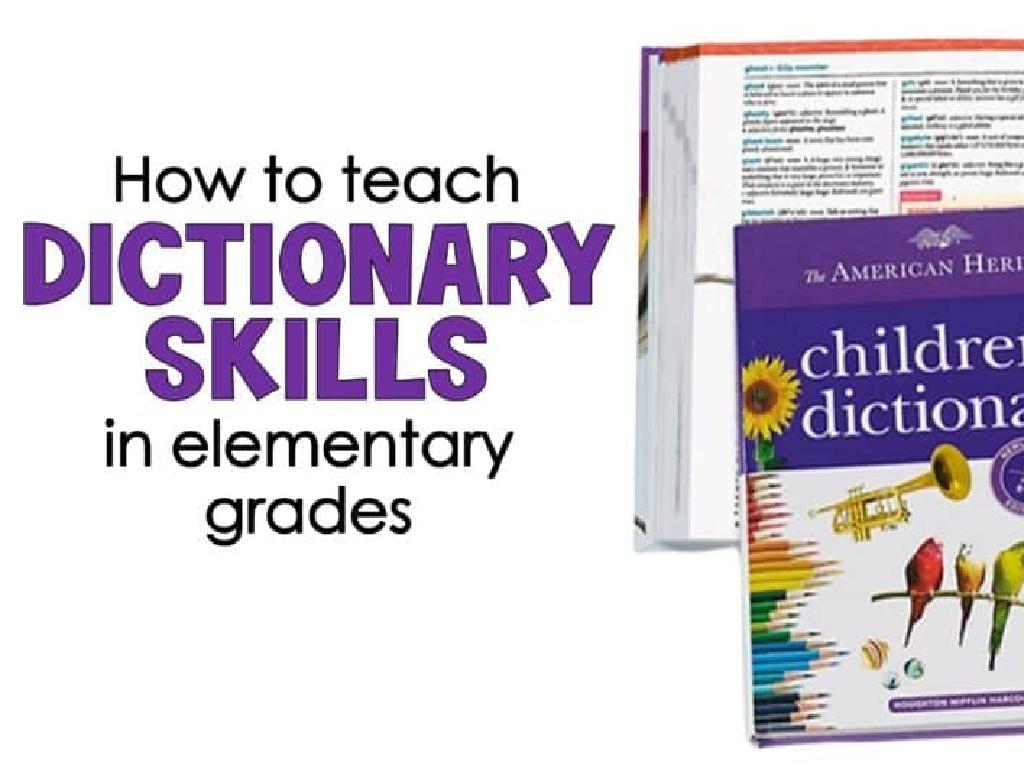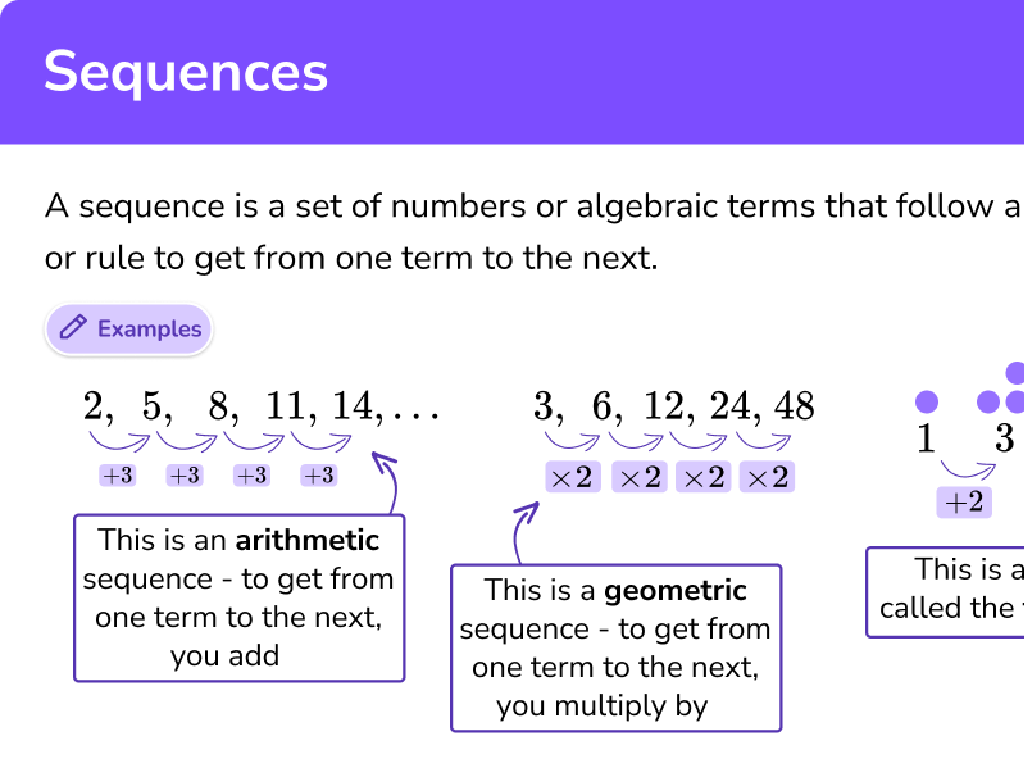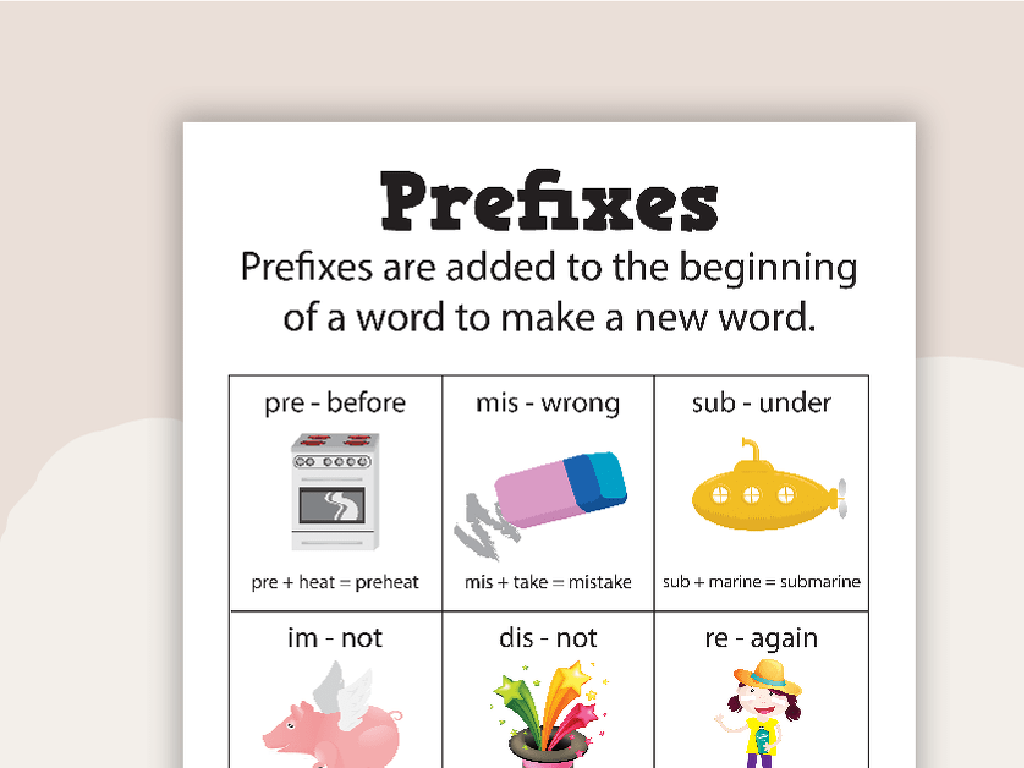Convert Between Standard And Expanded Form
Subject: Math
Grade: Fifth grade
Topic: Whole Numbers And Place Value
Please LOG IN to download the presentation. Access is available to registered users only.
View More Content
Welcome to Place Value!
– Grasping place value importance
– Place value determines a digit’s value in a number based on its position.
– Exploring whole numbers
– Whole numbers are all positive numbers without fractions or decimals.
– Converting to expanded form
– Break down a number into the sum of each digit multiplied by its place value.
– Reverting to standard form
– Combine the values of each digit to write the number in standard form.
|
This slide introduces the concept of place value, which is fundamental to understanding the base-ten number system used in mathematics. Emphasize the role of place value in determining the value of digits in whole numbers. Whole numbers are the set of non-negative integers, including zero. The goal for today’s lesson is to teach students how to convert whole numbers from standard form to expanded form and vice versa. In expanded form, a number is expressed as the sum of each digit multiplied by its place value (e.g., 345 = 300 + 40 + 5). Reverting to standard form is the process of combining these values back into a single number. Provide examples and practice problems to reinforce the concept.
Understanding Standard Form
– Standard form definition
– A method to write numbers using digits 0-9 where each has a place value.
– Examples of standard form
– For instance, 435 is in standard form; it represents 4 hundreds, 3 tens, and 5 ones.
– Uses of standard form
– It simplifies reading and writing large numbers, and is used in daily transactions.
|
This slide introduces the concept of standard form, which is a fundamental aspect of understanding place value in numbers. It’s important to emphasize that each digit in a number has a specific place value, which contributes to the number’s overall value. Provide clear examples to illustrate how numbers are composed in standard form, such as breaking down the number 435 into hundreds, tens, and ones. Discuss the practicality of standard form in everyday life, such as in financial transactions, where it allows for easy reading and writing of large numbers. Encourage students to practice converting numbers they encounter in daily life into standard form to reinforce the concept.
Understanding Expanded Form
– Expanded form explanation
– It breaks down a number to show each digit’s value.
– Examples of expanded form
– For 234: 200 + 30 + 4
– Relation to place value
– Shows how each digit is a different place value.
– Practice with different numbers
|
This slide introduces the concept of expanded form, which is a way of writing numbers to show the value of each individual digit. It’s important for students to understand that each digit in a number has a different place value and the expanded form makes this clear. For example, in the number 234, the digit 2 is in the hundreds place, 3 is in the tens place, and 4 is in the ones place. When we write it in expanded form, it becomes 200 + 30 + 4, which helps us see the value of each digit based on its position. Encourage students to practice converting various numbers into expanded form to reinforce their understanding of place value.
Place Value Review
– Review place value positions
– Ones, tens, hundreds, and so on
– Understand digit values
– Each digit has a value based on its position
– Quick quiz on place values
– Identify the value of digits in numbers like 435, 982
– Relate positions to expanded form
– How does 400 + 30 + 5 relate to 435?
|
Begin the lesson with a review of place value positions, ensuring students recall the order from ones to hundreds and beyond. Emphasize the value of each digit depending on its place within a number. For example, in the number 435, the digit 4 is in the hundreds place and thus represents 400. Conduct a quick quiz to assess students’ understanding of place values by asking them to identify the value of digits in various numbers. This will prepare them for converting between standard form (a number like 435) and expanded form (400 + 30 + 5). Use examples and encourage students to participate actively. This foundational understanding is crucial for mastering the concept of place value and will aid in their ability to convert between different forms of numbers.
Converting Standard to Expanded Form
– Steps to convert to expanded form
– Break down each digit by its place value
– Let’s practice conversion together
– We’ll do a few examples as a group activity
– Review examples as a class
– Look at how numbers break down in real examples
– Check your understanding
|
This slide is aimed at teaching students the process of converting numbers from standard form to expanded form. Begin by explaining the concept of place value and how each digit in a number has a specific value depending on its position. Demonstrate the step-by-step process of breaking down a number into its individual place values and then combining them to form the expanded version. Engage the class with a group activity to practice this skill together, using a variety of numbers. Afterward, review several examples as a class to ensure understanding. Finally, assess students’ grasp of the concept with individual or paired practice problems where they can apply what they’ve learned.
Converting Expanded to Standard Form
– Steps to convert expanded to standard
– Start with the largest place value, add each value together
– Group practice with examples
– Work together to solve problems, learn from each other
– Discuss common conversion mistakes
– Mixing up place values or incorrect addition
– Tips to remember the process
– Double-check work, understand place value importance
|
This slide is aimed at teaching students the process of converting numbers from expanded form to standard form. Begin by explaining each step clearly, using an example such as converting 300 + 40 + 5 into 345. Emphasize the importance of starting with the largest place value and working down to the smallest. During group practice, encourage collaboration and discussion among students to solve given problems. Highlight common mistakes, such as mixing up place values or adding incorrectly, and provide tips to avoid these errors, like double-checking work and reinforcing the concept of place value. This interactive approach helps students understand and remember the conversion process.
Interactive Practice: Standard & Expanded Form
– Interactive whiteboard activity
– Pair up to convert numbers
– Work with a partner to practice converting numbers from standard to expanded form and vice versa
– Discuss various methods
– Share different strategies used during the activity
– Reflect on learning outcomes
– Discuss what was learned and any challenges faced
|
This slide sets up an interactive class activity using the whiteboard. Students will be paired to encourage collaboration. They will convert numbers from standard to expanded form and vice versa, using the whiteboard to display their work. After the activity, lead a class discussion to explore the different methods students used. This will help them understand that there can be multiple ways to approach a problem. Encourage students to reflect on their learning outcomes and discuss any challenges they encountered. This activity aims to solidify their understanding of number forms through hands-on practice and peer learning.
Real-World Application of Place Value
– Importance of place value
– Place value helps in understanding the value of each digit in a number.
– Examples: prices and distances
– Prices help understand decimals; distances show large numbers.
– Expanded form and large numbers
– Breaking down numbers into units, tens, hundreds makes large numbers easier to understand.
|
Understanding place value is crucial in everyday life as it allows us to comprehend the value of numbers in different contexts, such as reading prices or measuring distances. For instance, recognizing that in $3.50, the 3 represents 3 dollars and the 50 represents 50 cents, is due to understanding place value. Similarly, knowing that 1,300 meters is 1 kilometer and 300 meters involves place value comprehension. Expanded form is a way to break down these numbers into their individual place values, making it easier to grasp the size of large numbers and perform calculations. Encourage students to think of other examples where they encounter numbers daily and how place value plays a role in understanding those numbers.
Class Activity: Number Expansion
– Create your own numbers
– Convert to expanded form
– Break down the number into the sum of its digits, each multiplied by its place value
– Convert to standard form
– Add the values together to form the original number
– Share with the class
|
This activity is designed to help students understand the relationship between standard form and expanded form of numbers. Students will create their own multi-digit numbers, then practice converting those numbers into expanded form by breaking them down into each digit multiplied by its place value. Afterward, they will convert the numbers back into standard form by adding the values together. Encourage creativity in number creation and ensure that students are comfortable with place values. Possible activities: 1) Students can use dice to generate random numbers. 2) Pair students up to check each other’s work. 3) Create a ‘gallery walk’ where numbers are displayed around the room for students to see different examples. 4) Have a ‘number challenge’ where students write the longest expanded form. 5) Use number cards to build and expand numbers physically.
Wrapping Up: Standard & Expanded Form
– Review of standard & expanded form
– Homework: 10 conversion exercises
– Convert 5 numbers from standard to expanded form and 5 from expanded to standard.
– Next lesson: Introduction to decimals
– Get ready to explore numbers beyond whole numbers.
– Practice makes perfect!
|
As we conclude today’s lesson on converting between standard and expanded form, it’s important to reinforce the concept through practice. For homework, students are tasked with converting 5 numbers from standard to expanded form and vice versa, ensuring they understand both directions of conversion. This will prepare them for the next class, where we will begin to explore decimals, a natural extension of their understanding of place value. Encourage students to approach their homework with the mindset that practice will solidify their skills and build a strong foundation for upcoming lessons.





